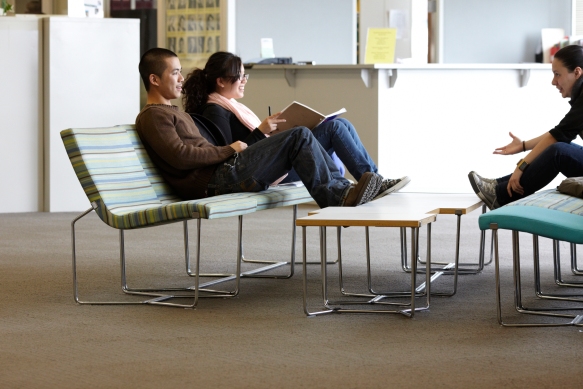Most students in traditional classrooms have no problem identifying the difference between “learning” and “doing,” or “teacher” and “student.”
But on Habitat for Humanity work sites, those lines are blurred. Volunteers don’t learn a skill and then do it, they learn as they do it. Similarly, someone who is a “learner” in the morning might be a “teacher” after lunch.
“Every day there’s all kinds of teaching and learning going on at our work sites,” says Chris Hall, Director of Construction Operations at Habitat for Humanity Kent County, in West Michigan. “Every site is staffed by a professional builder with all the skills, but it’s really an organic learning process. Sometimes you’re the teacher, sometimes you’re the student.”
When People and Disciplines Collaborate, More Learning Happens
The teaching and learning takes on a slightly more formal bent through the Habitat chapter’s collaborations with local schools. Students who take the “New Construction” course at Grand Rapids Community College apply their knowledge about sustainable building to Habitat homes; a Grand Rapids Public School magnet called the Academy of Design and Construction also extends its classrooms to Habitat building sites (pictured above).
“These days, with green building practices, you have to see the home as a living, breathing organism,” says Hall. “Everything is interconnected—it’s not just about physics, or just about geography or math. When the students work on these projects they can see how everything ties together.”
And at the end of the day, they can also point to what their knowledge helped them make.
“There’s something special that happens on a Habitat site, with everyone learning and working together,” Hall says.
Engaging Students with Hands-on Learning
This level of engagement and concrete accomplishment are also at the heart of a new Youth Recording Arts Academy—a joint project of the Grand Rapids Community Media Center and the Mackinaw Harvest professional recording studio. The intense, 12-week program focuses on hands-on work and experimentation in the recording studio, as well as developing “soft skills” like reliability and teamwork.
Laurie Cirivello of the Community Media Center has witnessed the benefits of active learning, both in the at-risk teens at the Academy, and as a parent to two non-traditional learners.
“Hands-on learning is so important—at the end of the day to be able to point to something and say, ‘I did this.’ My kids thrived on that,” Cirivello says. “With these kids, if we just keep saying, ‘Stay in school, stay in school’ with only the promise of ‘Someday you’ll get to do something that will rock your world,’ it isn’t going to work. They need to be engaged now.”
How the Shift Toward Active, Social Learning is Impacting Classrooms
Allison Roon, an interior designer, adjunct professor and long-time izzy+ consultant, says there’s an entire field of study backing up why learning is more effective when it’s more active. Roon, who has a Master’s degree in Adult and Higher Education, says “active learning” is all about students creating meaning through experiences and reflection (she cites scholar and professional consultant L. Dee Fink).
“Adult students, in particular, need to feel a personal connection to the learning that is happening for it to be meaningful,” Roon says. “And we’re not only moving away from teacher-centered education, but today’s student-centered models are also being joined by more informal, social, collaborative styles of learning outside classrooms.”
Not surprisingly, all of these shifts in teaching and learning ultimately impact built learning environments—whether you’re looking at more flexible and collaborative ways to design classrooms or you’re creating cafes and lounges that encourage informal learning and conversation. Roon says universities across the country are starting to minimize their number of traditional classroom spaces to allow for greater informal learning spaces. Some schools in Europe have even hit a 60 to 40 ratio of formal to informal spaces.
“The future of learning involves figuring out how to turn all of these experiences into meaningful learning,” says Roon. “izzy+ focuses a lot of time and thought on this—not just in classrooms, but also when it comes to creating informal, inspiring places that encourage people to come together to share ideas, be creative and learn.”
For more on our learning products and research, be sure to check out the Learning section of our website.
Students learn and share in an izzy+-designed “third space” at the Borough of Manhattan Community College
Students at Atlanta Technical College collaborate around Dewey tables by izzy+



